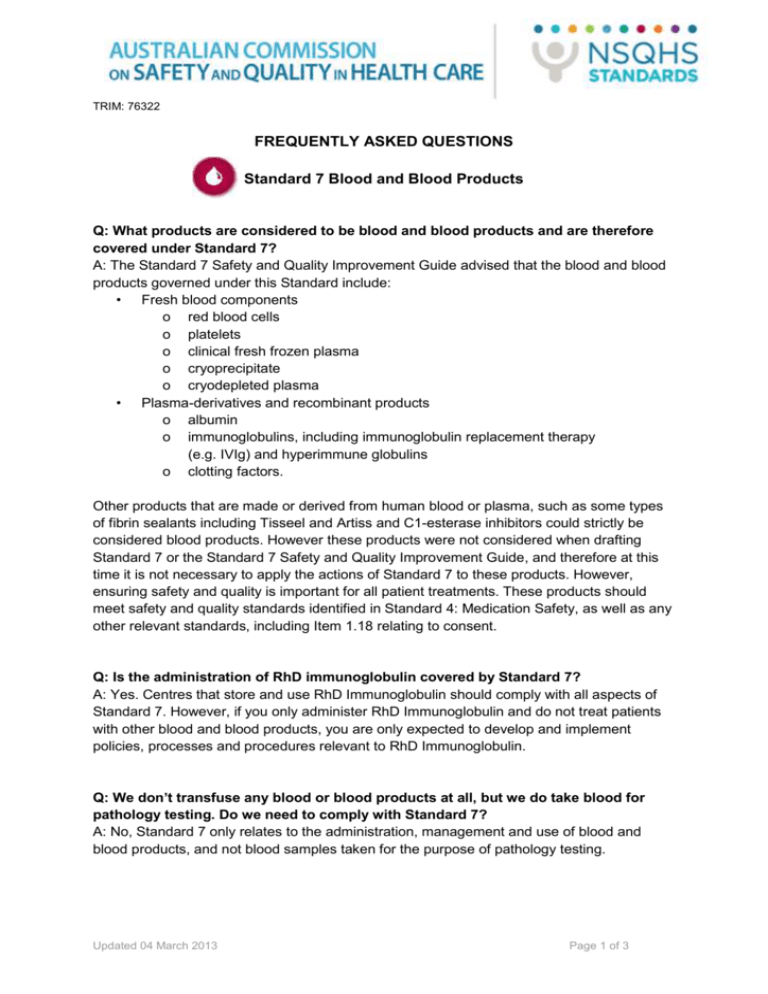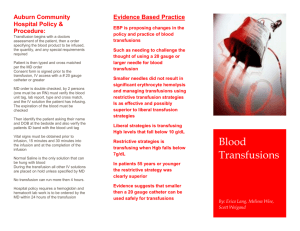WEB-FAQ-Standard
advertisement

TRIM: 76322 FREQUENTLY ASKED QUESTIONS Standard 7 Blood and Blood Products Q: What products are considered to be blood and blood products and are therefore covered under Standard 7? A: The Standard 7 Safety and Quality Improvement Guide advised that the blood and blood products governed under this Standard include: • Fresh blood components o red blood cells o platelets o clinical fresh frozen plasma o cryoprecipitate o cryodepleted plasma • Plasma-derivatives and recombinant products o albumin o immunoglobulins, including immunoglobulin replacement therapy (e.g. IVIg) and hyperimmune globulins o clotting factors. Other products that are made or derived from human blood or plasma, such as some types of fibrin sealants including Tisseel and Artiss and C1-esterase inhibitors could strictly be considered blood products. However these products were not considered when drafting Standard 7 or the Standard 7 Safety and Quality Improvement Guide, and therefore at this time it is not necessary to apply the actions of Standard 7 to these products. However, ensuring safety and quality is important for all patient treatments. These products should meet safety and quality standards identified in Standard 4: Medication Safety, as well as any other relevant standards, including Item 1.18 relating to consent. Q: Is the administration of RhD immunoglobulin covered by Standard 7? A: Yes. Centres that store and use RhD Immunoglobulin should comply with all aspects of Standard 7. However, if you only administer RhD Immunoglobulin and do not treat patients with other blood and blood products, you are only expected to develop and implement policies, processes and procedures relevant to RhD Immunoglobulin. Q: We don’t transfuse any blood or blood products at all, but we do take blood for pathology testing. Do we need to comply with Standard 7? A: No, Standard 7 only relates to the administration, management and use of blood and blood products, and not blood samples taken for the purpose of pathology testing. Updated 04 March 2013 Page 1 of 3 Q: What does “vetting of transfusion requests” mean (as mentioned in 7.1.2 in the Hospital Accreditation Workbook)? A: Vetting of transfusion requests or product orders refers to examining the request for blood products prior to issuing of the blood product. It is undertaken to assess transfusions against guidelines or protocols and improve appropriateness of transfusion requests. This is important to reduce unnecessary exposure to potential risks, and to assist in developing knowledge and improving uptake of evidence based practices. At a health service this may involve implementing a process whereby the person ordering the product may have to provide support that the request meets clinical guidelines. For example, in the case of red cells, the request for transfusion may identify the reason why the transfusion is required, such as a low haemoglobin level. It may be the role of a transfusion nurse or laboratory scientist to check that the transfusion request or product order includes sufficient information to check compliance with clinical guidelines, and that the request does in fact meet the guidelines. Evidence that this occurs could be in the form of a protocol and report against the protocol which could include documentation of who is responsible for vetting requests, and evidence that they have undertaken such vetting. It may include audit documentation of the number of requests that are amended following checking for appropriateness, or the proportion of transfusion requests or products orders that are considered appropriate based on clinical guidelines. Another form of evidence could be the inclusion of this task in a job description, and a performance management report that states the person in this role is undertaking this activity. Q: Action 7.11.1 states that informed consent is undertaken and documented for blood and blood products. Does this apply to fresh blood transfusions only, or all products covered under the standard including products such as RhD Immunoglobulin and IVIg? A: Consent is required for transfusion of all blood and blood products covered under Standard 7 (link to FAQ 1). The consent policy of your organisation should reflect intent to receive informed consent for all transfusions of all blood and blood product. You should note that Action 7.11.1 is developmental. If you are having difficulty with this requirement, you may choose to develop an implementation plan focussing initially on fresh blood products. However, to be compliant with this recommendation you should be able to demonstrate that you are working toward ensuring informed consent is provided for transfusion of all blood and blood products. Q: Our hospital doesn’t look after the storage of blood and blood products, nor monitor wastage. This is done by a contracted pathology provider. What should I be looking at? A: Where any component of health service management relating to blood and blood product is outsourced, you remain responsible for ensuring the safety and quality of those blood and blood products that are used in your health service organisation. You should have contract obligations in place requiring the outsourced provider to meet the requirements of Standard 7, and require them to provide reports that allow you to confirm the activities of the Updated 04 March 2013 Page 2 of 3 contracted organisation satisfy the requirements under this Standard (and require the implementation of quality improvement activities as required). You could have these reports reviewed by your transfusion governance group, and provide evidence that these had been reviewed and any concerns addressed should be documented. You should also monitor the management of blood and blood products within your organisation. This may include storage and handling (such as in a ward or surgery), as well as wastage of products at these locations. Updated 04 March 2013 Page 3 of 3









